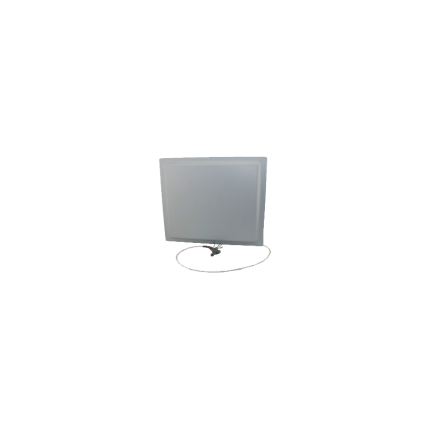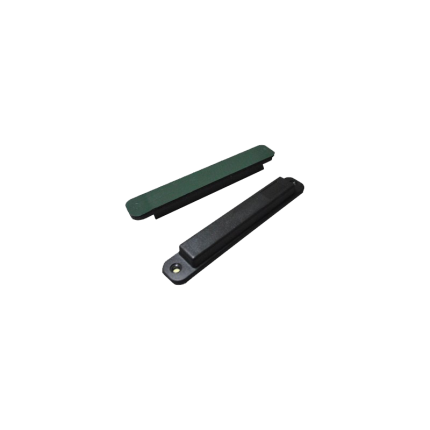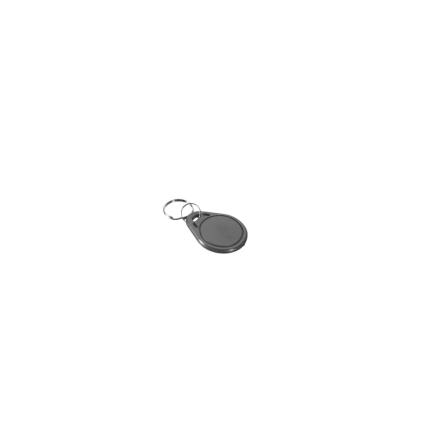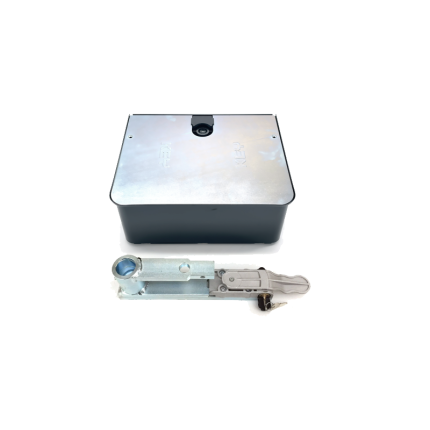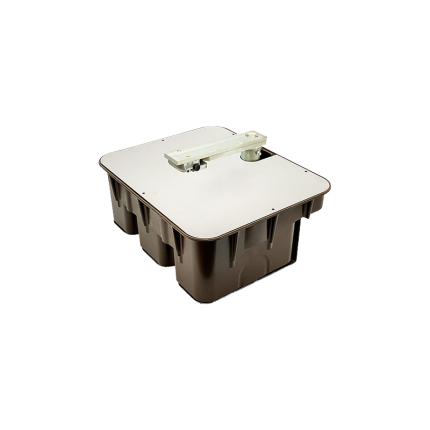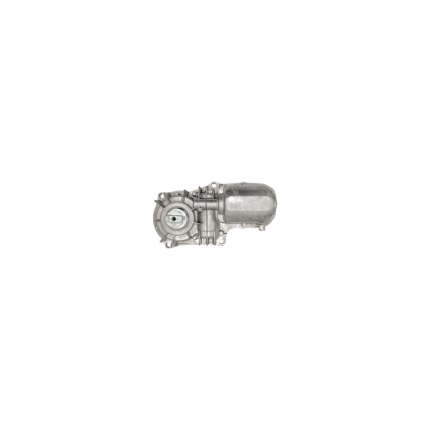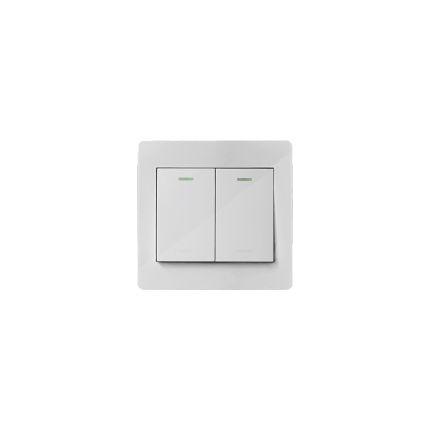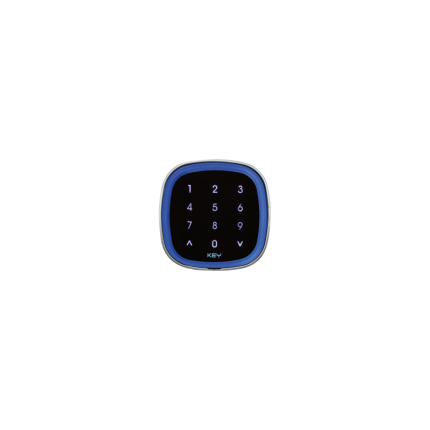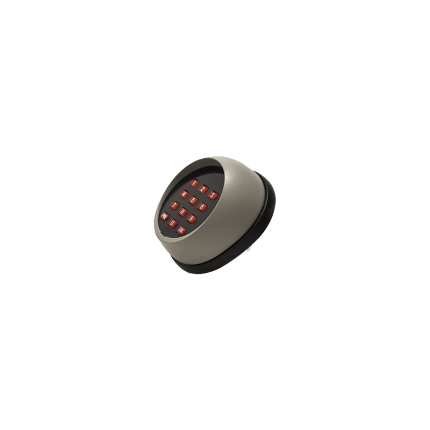driveway gates
UHF Gate Controller
Ship or pick up from our office.
UHF Gate Controller
A UHF Gate Controller is a system that uses Ultra-High Frequency (UHF) Radio Frequency Identification (RFID) technology to manage and control access through a gate or designated entry/exit point. It typically consists of a UHF RFID reader, antennas, and a control unit that processes the data and triggers the gate mechanism. It's designed for automated, hands-free identification and tracking of people or objects equipped with UHF RFID tags, offering a longer read range and faster processing compared to other RFID frequencies. How it Works The fundamental principle of a UHF Gate Controller relies on the interaction between a UHF RFID reader and UHF RFID tags. Here's a breakdown:- UHF RFID Reader and Antennas: The gate controller incorporates a UHF RFID reader connected to one or more antennas. These antennas emit radio waves in the UHF frequency band (typically 860-960 MHz).
- RFID Tags: People, vehicles, or items needing access are equipped with UHF RFID tags. These tags contain a microchip that stores data (like a unique ID) and an antenna. Passive UHF tags, which are common in these systems, do not have their own power source; they draw power from the radio waves emitted by the reader.
- Data Exchange: When a tagged item or person enters the read range of the gate's antennas, the RFID tag is energized by the reader's radio waves. The tag then modulates these waves to send its stored data back to the reader.
- Data Processing and Control: The UHF RFID reader receives the tag's data and sends it to a control unit (often an integrated part of the gate system or a separate access controller). This control unit verifies the tag's information against a database of authorized entries.
- Gate Activation: If the tag is authorized, the control unit sends a signal to open or enable the gate (e.g., a barrier arm, turnstile, or door lock). If the tag is unauthorized, access is denied, and an alarm might be triggered.
- Directional Detection and Anti-Collision: Advanced UHF gate controllers can detect the direction of movement (e.g., entering or exiting) and employ anti-collision algorithms to read multiple tags simultaneously, even in high-traffic scenarios. Some systems use additional sensors (like infrared) to improve accuracy and prevent "tailgating."
- Long Read Range: Typically able to read tags from several meters away, allowing for "hands-free" and "drive-through" access.
- High Reading Speed: Can quickly identify multiple tags in motion, reducing bottlenecks.
- Anti-Collision: Algorithms that allow the reader to differentiate and read multiple tags present in the field at the same time.
- Directional Sensing: Ability to determine if an item or person is entering or exiting the controlled area.
- Integration Capabilities: Often connect with other security or management systems via interfaces like Ethernet, RS232, RS485, or Wi-Fi.
- Robust Design: Many are built for industrial or outdoor environments, with resistance to dust and water.
- Vehicle Access Control: Managing entry and exit for parking lots, gated communities, corporate campuses, and toll roads. Vehicles can have tags on windshields, allowing for seamless, hands-free access.
- People Access Control: Controlling access to buildings, restricted areas, and for time and attendance tracking in offices, universities, hospitals, and event venues.
- Logistics and Warehouse Management: Monitoring the flow of goods, pallets, and containers in and out of warehouses, distribution centers, and production lines for inventory management, asset tracking, and theft prevention.
- Retail: Used at store exits for Electronic Article Surveillance (EAS) to prevent shoplifting, and for inventory tracking as items move in and out of the backroom.
- Libraries and Document Management: Tracking books, documents, and other assets as they enter or leave a facility.
- Manufacturing: Monitoring materials and finished products on production lines and at factory entrances/exits.
UHF Label
Ship or pick up from our office.
UHF Label
A UHF (Ultra-High Frequency) label access control system uses radio-frequency identification (RFID) technology operating in the ultra-high frequency range (typically 860-960 MHz) to manage and control access to specific areas, buildings, or resources. It's a touchless, automated system that offers long-range reading capabilities and the ability to identify multiple items simultaneously, making it highly efficient for various applications like vehicle access, personnel tracking in large facilities, and event management. 🛂 How it Works The core principle of a UHF label access control system relies on the communication between RFID tags (labels) and RFID readers. Here's a breakdown of the process:- RFID Tags (Labels): These are small electronic devices, often in the form of adhesive labels, cards, or embedded devices. They contain a microchip that stores unique identification data and an antenna. Most UHF tags used in access control are passive, meaning they don't have their own power source and rely on the energy emitted by the reader.
- RFID Reader: The reader emits radio waves, creating an electromagnetic field. When a UHF RFID tag enters this field, it absorbs energy from the waves, which powers its microchip.
- Data Transmission: Once activated, the tag modulates the waves to transmit its stored data (its unique ID) back to the reader.
- Data Processing and Verification: The reader captures and decodes this data, then sends it to a central access control system (often a computer with specialized software and a backend database). The system verifies the tag's unique ID against a list of authorized credentials and pre-defined access rules.
- Access Granting/Denial: If the tag is authorized, the system sends a signal to unlock a door, open a gate, or grant access. If not authorized, access is denied, and the system may trigger an alarm or log the attempted entry.
- Logging: The system typically records all entry and exit events, providing a detailed audit trail for security and management purposes.
- UHF RFID Tags/Labels: These are the physical identifiers worn by individuals or attached to vehicles/assets. They store the unique ID and are read by the system.
- UHF RFID Readers: These devices emit radio waves to power and read the data from the tags. They are strategically installed at entry/exit points (e.g., doorways, gates). Fixed readers are common for specific zones, while handheld readers offer flexibility for mobile applications like inventory or searching for tags.
- Antennas: Connected to the readers, antennas are responsible for transmitting and receiving the radio signals. The type and placement of antennas affect the read range and coverage area.
- Access Control Software/System: This is the "brain" of the system. It manages the database of authorized tags, processes the data received from readers, applies access rules, and controls the locking mechanisms. It often integrates with other security or building management systems.
- Backend Database: Stores all the information related to RFID tags, authorized users, access levels, and event logs.
- Locking Mechanisms: These are the physical devices controlled by the system, such as electronic door locks, gate barriers, or turnstiles.
- Long Read Range 📏: UHF systems can read tags from several meters away (typically 3-10 meters, and sometimes up to 25 meters or more), allowing for hands-free and rapid access, particularly useful for vehicles or large volumes of people.
- High-Speed Data Transmission and Multi-Tag Reading ⚡: They can read multiple tags simultaneously (often over 100 tags per second), significantly improving efficiency in high-traffic areas and during events.
- Enhanced Efficiency ⏱️: Automation of access eliminates manual checks, reduces queuing times, and frees up staff for other tasks.
- Improved Security 🔒: Each tag has a unique identifier, making it difficult to forge or duplicate. The system provides real-time monitoring and detailed audit trails, enhancing accountability and security. Integration with other systems like surveillance cameras can further bolster security.
- Touchless Operation 🖐️: The long read range enables touchless access, which is beneficial for hygiene, particularly in high-traffic areas or environments where physical contact should be minimized.
- Scalability 📈: UHF RFID systems can be easily scaled to accommodate a growing number of users and access points without compromising performance.
- Durability and Resistance 💪: UHF tags are often resistant to environmental factors like water, oil, and chemicals, and the data stored on their chips is protected. They can also be reused.
- Reduced Wear and Tear: As there's no physical contact with readers, the system components experience less wear and tear, leading to lower maintenance costs.
UHF Licence Plate
Ship or pick up from our office.
UHF Licence Plate
A UHF (Ultra High Frequency) Licence Plate access control system is a vehicle identification and access management solution that uses UHF RFID (Radio Frequency Identification) technology to automatically grant or deny entry to vehicles. Instead of relying on traditional license plate recognition (ANPR/LPR) which uses cameras to read visible plates, UHF systems use RFID tags, often in the form of stickers or cards, affixed to vehicles. 🚗 When a vehicle with a registered UHF RFID tag approaches an access point (like a gate or barrier), a UHF reader emits radio waves. The tag, powered by these waves, transmits its unique identification data back to the reader. This data is then sent to an access control system which verifies the vehicle's authorization. If authorized, the system triggers the gate to open, allowing for fast, hands-free, and seamless entry and exit. This technology is widely used in places requiring efficient and secure vehicle flow, such as:- Gated communities 🏡
- Parking facilities (corporate, commercial, residential) 🅿️
- Industrial sites and logistics hubs 🏭
- Toll roads 🛣️
- UHF RFID Tags: These are small, passive (battery-less) or semi-active devices that contain a microchip storing a unique identification number and an antenna. They are typically affixed to the vehicle's windshield or license plate. When exposed to radio waves from a reader, the tag's antenna collects energy, powering the microchip to transmit its data.
- UHF RFID Readers: These devices are installed at access points (e.g., gate entrances) and emit radio waves to detect and read the RFID tags on approaching vehicles. They have antennas to send and receive signals, and a processor to decode the data from the tags. UHF readers typically have a longer read range (up to 10-12 meters or more) compared to other RFID frequencies, allowing vehicles to pass without fully stopping.
- Access Control System (Software/Controller): This is the "brain" of the system. The reader sends the tag's ID number to this system. The access control software then compares this ID with its database of authorized vehicles. Based on pre-defined criteria (e.g., specific times of day, authorized user groups), it determines whether to grant or deny access.
- Barrier/Gate System: If access is granted by the control system, a signal is sent to the physical barrier (like a boom gate or sliding gate), which opens to allow the vehicle to pass.
- Speed and Efficiency 🚀: Vehicles don't need to stop or roll down windows, significantly reducing traffic congestion, especially during peak hours. This provides a "frictionless" entry experience.
- Long Read Range 📏: UHF RFID allows for detection from several meters away, enabling quick processing of vehicles even at higher speeds.
- Reliability in Diverse Conditions 🌧️☀️: Unlike optical ANPR systems that can be affected by dirt, rain, snow, or poor lighting, UHF RFID tags are generally more robust and less susceptible to environmental factors.
- Enhanced Security 🔒: RFID tags are difficult to duplicate or tamper with, offering a higher level of security than some other methods. The system also logs all entries and exits, providing a clear audit trail.
- Reduced Operational Costs 💰: Automation minimizes the need for manual gate attendants, leading to lower labor costs over time. There's also no need for physical cards or key fobs that can be lost or damaged, saving on replacement costs.
- Integration Capabilities 🔗: These systems can often integrate seamlessly with other security and management platforms, such as visitor management systems, surveillance cameras, and parking management software, for a comprehensive solution.
UHF Tag
Ship or pick up from our office.
UHF Tag
A UHF (Ultra-High Frequency) tag access control system is a security solution that uses radio frequency identification (RFID) technology operating in the ultra-high frequency range (typically 860-960 MHz) to control and monitor entry and exit of individuals or vehicles to restricted areas. 🛂 It's an automated system that identifies an individual or object with a unique RFID tag and, based on pre-defined permissions, grants or denies access. Unlike traditional barcode systems, UHF RFID doesn't require a direct line of sight between the tag and reader, allowing for longer read ranges and the ability to read multiple tags simultaneously. How It Works A UHF tag access control system generally consists of four main components:- UHF RFID Tags: These are small electronic devices containing a microchip and an antenna. The microchip stores data, such as a unique identifier or user information. Passive UHF tags, the most common type, are powered by the electromagnetic field emitted by the reader. Active tags have their own battery, enabling longer read ranges and continuous data transmission.
- UHF RFID Readers: These devices emit radio waves to create an electromagnetic field. When a UHF tag enters this field, it absorbs energy (for passive tags) and uses it to power its microchip. The tag then modulates the waves to transmit its stored data back to the reader. Readers can be fixed at entry points (like doors or gates) or handheld.
- Antennas: Integrated with the reader, antennas are responsible for transmitting and receiving the radio signals. Their design and placement are crucial for optimizing read performance and range.
- Access Control Software/Server: This is the "brain" of the system. The reader sends the decoded tag data to the software, which compares it against a database of authorized users and their assigned access levels. If the credentials match, the software sends a signal to unlock the door, open a gate, or trigger another access action. This software also logs all access events, providing an audit trail.
- Long Read Range: UHF systems can read tags from several meters away, making them ideal for applications like vehicle access control where you don't need to stop and present a card.
- High Read Speed and Multi-Tag Reading: They can quickly read multiple tags at once, which is beneficial in high-traffic areas or for tracking numerous assets simultaneously.
- Automation and Efficiency: Automated identification eliminates the need for manual checks, speeding up entry and exit processes.
- Enhanced Security: By identifying individuals and logging access events, these systems improve security and accountability. Features like encryption and unique IDs help prevent unauthorized access and cloning.
- Durability: UHF tags are often designed to be robust and can withstand various environmental conditions, making them suitable for outdoor or industrial use.
- Scalability: Systems can be easily expanded to cover more access points or accommodate a larger number of users.
- Vehicle Access Control: Automatically granting access to parking lots, gated communities, or corporate campuses without requiring drivers to stop and swipe a card.
- Building and Room Access: Controlling entry to offices, secure areas, or sensitive facilities for employees and authorized personnel.
- Event Management: Using RFID-enabled wristbands or badges for quick and efficient entry to concerts, theme parks, or VIP areas.
- Asset Tracking: While primarily for access, the same technology can track the movement of valuable assets within a controlled environment.
- Personnel Tracking: Monitoring the presence and movement of staff within a facility for safety or operational purposes.
- Interference: Performance can be affected by certain materials like metal and liquids in the environment, which can interfere with radio waves.
- Cost: Initial installation costs can be higher compared to simpler access control methods due to the specialized hardware and software.
- Regulatory Compliance: UHF frequencies are not globally harmonized, meaning system components must comply with regional radio regulations.
- Security Risks: While secure, like any digital system, there's a potential for sophisticated cloning or hacking attempts if not properly secured with encryption and robust protocols.
Underground dual swing gate opener -Key Automation UND3024
Ship or pick up from our office.
Product Sheet PDFUnderground dual swing gate opener -Key Automation UND3024
*Suitable gate weight: Maximum 600 Kg (Per leaf) Included: *2 x Electromechanical motor *2 x Foundation box *1 x Main control board *1 x KUBE *1 x Waterproof box *2 x Remote control *2 x Manual release key *1 x Set safety sensorThe Key Automation UND3024 is an underground dual swing gate opener system, designed for automating the opening and closing of swing gates, particularly those with two leaves that meet in the middle.
It is known for its discreet, almost invisible, installation, with the motor and mechanism hidden underground. This makes it a popular choice when aesthetics are a priority.
Here's a more detailed breakdown:
-
Dual Swing Configuration:The UND3024 is specifically designed for gates with two leaves that swing open from a central point.
-
Underground Installation:The motor and operating mechanism are installed below ground, within foundation boxes, minimizing the visual impact of the system.
-
Electromechanical Operation:The system utilizes an electromechanical motor to drive the gate opening and closing mechanism.
-
Control System:A control board, housed in a separate waterproof box, manages the system's operation, receiving signals from remote controls or other access control devices.
-
Safety Features:The system typically includes safety features such as obstruction detection and an emergency release mechanism for manual operation.
-
Aesthetics:The underground design offers a discreet and aesthetically pleasing solution, particularly suitable for properties where appearance is a key consideration.
-
Applications:The UND3024 is suitable for both residential and light commercial use, automating driveway gates.
-
Components:The system usually includes two underground operators, foundation boxes, a control board, remote controls, and safety sensors.
Underground Dual Swing Gate Opener -VDS RG110
Ship or pick up from our office.
Product Sheet PDFUnderground Dual Swing Gate Opener -VDS RG110
*Suitable gate weight: Maximum 500 Kg (Per leaf) Included: *2 x Electromechanical motor *2 x Foundation box *1 x Main control board *1 x Waterproof box *2 x Remote control *2 x Manual release key *1 x Safety sensor The Swing gate opener -VDS Underground RG110 is one of the best underground swing gate operators that can be installed for the swing driveway gates. The Swing gate opener -VDS Underground RG110 is Italian-made and can be installed for heavy swing gates. *Electromechanical Motor *Maximum gate weight: 500 Kg *120 VUnderground single swing gate opener -Key Automation UND3024
Ship or pick up from our office.
Product Sheet PDFUnderground single swing gate opener -Key Automation UND3024
*Suitable gate weight: Maximum 600 Kg Included: *1 x Electromechanical motor *1 x Foundation box *1 x Main control board *1 x KUBE *1 x Waterproof box *2 x Remote control *1 x Manual release key *1 x Set safety sensorThe Key Automation UND3024 is an underground single swing gate opener.
It's designed for discreet, concealed automation of swing gates, meaning the motor and operating mechanism are installed underground, keeping the gate's appearance visually clean.
This system is suitable for both residential and commercial applications, offering a modern and robust solution for gate access.
Here's a more detailed explanation:
-
Concealed Installation:The motor and mechanical components are installed beneath the ground, within foundation boxes, making the system virtually invisible and preserving the gate's aesthetic.
-
Gate Compatibility:The UND3024 is designed to work with various gate materials, including steel, wood, and vinyl.
-
Operation:It utilizes an electric motor to power the gate's movement, with a control system that receives signals from remote controls, keypads, or other access control devices.
-
Key Features:
- Safety: Many models include features like anti-crushing devices and speed slowdown to ensure safe operation.
- Durability: Underground openers are often constructed with durable materials like die-cast aluminum and stainless steel to withstand outdoor conditions.
- Silent Operation: Underground openers can be engineered for quiet operation.
- Easy Installation: Some models offer simplified installation procedures.
- Optional Features: Battery backup, remote controls, and safety sensors are often available as optional additions.
- Safety: Many models include features like anti-crushing devices and speed slowdown to ensure safe operation.
-
Swing Gate Types:
- Single Swing: A single leaf gate that moves in one direction.
- Double Swing: A gate with two leaves that swing open from the center.
- Single Swing: A single leaf gate that moves in one direction.
-
Benefits of Underground Openers:
- Discreet Appearance: The concealed mechanism preserves the gate's aesthetics.
- Space Efficiency: They don't require the space needed for external motor arms.
- Durability: They are designed for long-term use and resistance to corrosion.
- Security: They can be an effective way to prevent unauthorized access to a property.
- Convenience: Automatic opening and closing of the gate with remote control or other access methods.
- Accessibility: Can be especially useful for people with mobility issues.
- Discreet Appearance: The concealed mechanism preserves the gate's aesthetics.
Underground swing gate opener -Key Automation UND3024
Ship or pick up from our office.
Underground swing gate opener -Key Automation UND3024
*Electromechanical Motor *Maximum gate weight: 600 Kg *DC 24 VWireless Doorbell
Ship or pick up from our office.
Wireless Doorbell
A wireless doorbell is a modern type of doorbell that operates without the need for physical wiring between the outdoor button and the indoor chime unit. Unlike traditional wired doorbells that rely on an electrical circuit, wireless doorbells use radio waves (or sometimes Wi-Fi or Bluetooth) to transmit a signal when the button is pressed. Here's a breakdown of its key components and how it works:- Transmitter (Doorbell Button): This is the part located outside your door that a visitor presses. It typically contains a small battery (though some "kinetic energy" versions generate power from the press itself) and sends a wireless signal when activated.
- Receiver (Chime Unit): This is the indoor component that produces the sound (chime or melody) when it receives the signal from the transmitter. Receivers can be battery-operated for portability or plug into a standard electrical outlet.
- When a visitor presses the doorbell button (transmitter), it sends a unique radio frequency (RF) signal.
- The signal travels wirelessly through the air.
- The receiver inside your home detects this signal.
- Upon receiving the signal, the receiver activates its chime or melody, alerting you to the visitor.
- Easy Installation: No need for complex wiring, drilling holes, or hiring an electrician. This makes them ideal for renters or anyone looking for a quick and simple setup.
- Flexibility and Portability: Since there are no wires, you can place the chime unit virtually anywhere in your home, and even move it around if needed. Many systems also allow for multiple receivers throughout a large house or property.
- Customization: Most wireless doorbells offer a variety of chime melodies and adjustable volume levels, allowing you to personalize the sound.
- Advanced Features (Smart Doorbells): Many modern wireless doorbells, often called "smart doorbells," integrate with Wi-Fi and offer additional features like:
- Video cameras: Allowing you to see who's at your door from your smartphone, even when you're not home.
- Two-way audio: Enabling you to speak with visitors remotely.
- Motion detection: Alerting you to activity outside your door.
- Smartphone notifications: Sending alerts to your phone when someone rings the bell or motion is detected.
- Integration with smart home systems: Connecting with other devices like smart lights or security systems.
- Enhanced Security: With features like video recording and remote monitoring, wireless doorbells can deter potential intruders and provide valuable evidence in case of an incident.
Wireless Keypad Access Control -Key Automation EGKTR1
Ship or pick up from our office.
Wireless Keypad Access Control -Key Automation EGKTR1
*Wireless*Rain Shield Cover Included
*Finger Touch *Back Light *Protection degree: IP 55The EGKTR1 is a wireless digital keypad manufactured by Key Automation, designed for access control, particularly for automatic gates and doors.
It utilizes capacitive touch technology and is compatible with Key Automation control units and receivers. The keypad allows for secure and convenient entry management using a user-defined code, eliminating the need for physical keys or remotes.
Here's a more detailed breakdown:
-
Wireless and Keyless Entry:The EGKTR1 enables keyless entry to properties by allowing users to enter a personalized code on the keypad to activate the gate or door.
-
Capacitive Touch Technology:This technology provides a responsive and durable touch surface, similar to a smartphone screen.
-
Compatibility:It's designed to work with Key Automation control units and receivers, making it a suitable addition to their access control systems.
-
Security Features:The EGKTR1 is a security device, providing controlled access to properties and can be programmed with multiple user codes.
-
Applications:It can be used for various applications, including commercial and residential buildings, educational institutions, and industrial facilities.
-
Installation and Programming:The keypad is designed for easy installation and programming, often with user-friendly instructions and procedures.
Wireless Keypad Access Control – ALEKO LM172
Ship or pick up from our office.
Wireless Keypad Access Control – ALEKO LM172
-Rain Shield Cover included *Backlight *433 MHz The ALEKO LM172 is a wireless keypad access control system primarily designed for use with ALEKO brand swing and sliding gate openers. It provides a secure and convenient way to control access to a property by requiring users to enter a programmable 6-digit code. Key Features & Specifications- Wireless Operation: It's completely wireless, eliminating the need for electrical connections to the gate opener. It operates on 3 AAA batteries.
- Frequency: It uses a 433.92 MHz frequency for communication with compatible gate openers.
- Security: Enhances security by restricting access to authorized individuals who know the programmable 6-digit code, reducing reliance on traditional remote controls.
- Durability: Features a rugged metal construction designed to withstand various weather conditions. Some listings mention heavy-duty iron construction.
- Visibility: Equipped with backlit keys for easy use in low-light conditions.
- Compact Design: Has a relatively compact profile (approx. 3.5"L x 3.25"W x 1"D or 4" x 3" x 3").
- Range: Offers a typical operating range of up to 32 feet (10 meters) from the gate opener's receiver. It's recommended to install it within 5 meters (16 feet) of the control box on the same side of the driveway to avoid interference.
- Installation: Designed for easy installation, typically mounted with screws. It can be buried in the ground or fixed on the ground with a compatible mounting post.
- ALEKO Swing Gate Openers: AS/GG Series (e.g., AS450, AS600, AS650, AS900, AS1200, AS1300, AS1700 models).
- ALEKO Sliding Gate Openers: AR/AC Series (e.g., AR900, AR1300, AR1800, AR2200, AR2700, AR5700, AC1300, AC1800, AC2200, AC2700, AC5700 models).
- LockMaster Gate Openers: LM901 and LM902 Swing Gate Openers.
- DSC DSR SCG/SFG (H model only) Sliding Gate Openers: Purchased after July 2011.
- Powering on the control board and ensuring it's in standby mode.
- Pressing a "LEARN" button on the control board.
- Pressing the "OK" button on the LM172 keypad to link it with the gate opener.
- Once successfully learned, the control board's LED will indicate confirmation.

